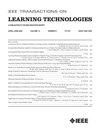How Can Self-Evaluation and Self-Efficacy Skills of Young Learners be Scaffolded in a Web Application?
IF 4.9
3区 教育学
Q2 COMPUTER SCIENCE, INTERDISCIPLINARY APPLICATIONS
引用次数: 0
Abstract
Self-regulated learning (SRL) skills are critical for students of all ages to maximize their learning. Two key processes of SRL are being aware of one's performance (self-evaluation) and believing in one's capabilities to produce given attainments (self-efficacy). To assess and improve these capabilities in young children (5–8), we use a literacy web application, where we introduced two randomly triggered prompts to evaluate perceived difficulty and desired difficulty. Comparing students' actual performance with their responses to self-regulatory prompts provides information about their ability to self-regulate their learning, in particular their self-evaluation and self-efficacy. The novelty of this work resides in studying the SRL of young children (5–8) in digital learning environments while learning another task (reading in our case), measuring and improving some SRL abilities themselves and not only measuring and improving academic results in other tasks, and the large number of students on which the studies were carried (over 400 000). Using 15 982 994 responses from 467 116 students, we first measured two types of SRL deficits, and then, we assessed how a scaffolding and remediation strategy can reduce these deficits. In Study 1, we compare a group receiving remediation feedback to a control group, whereas in Study 2, we determine the impact of age and level on the remediation efficiency. Our contribution is twofold: a method to address on the long term a deficit in self-evaluation or in self-efficacy in a digital learning environment, and a corroboration of the fact that students who are academically at risk lack self-efficacy and avoid tackling challenging exercises compared with their level. We, therefore, recommend that digital learning environments integrate an overlay of SRL, such as self-evaluation and self-efficacy remediation loops, especially for younger students and students who are struggling academically. We included notes for educational practitioners in this article for this purpose.如何在网络应用中培养青少年的自我评价和自我效能感技能?
自我调节学习(SRL)技能对于各年龄段的学生最大限度地提高学习成绩至关重要。自我调节学习的两个关键过程是意识到自己的表现(自我评价)和相信自己有能力取得既定成绩(自我效能感)。为了评估和提高幼儿(5-8 岁)的这些能力,我们使用了一个识字网络应用程序,其中引入了两个随机触发的提示,以评估感知难度和期望难度。比较学生的实际表现和他们对自我调节提示的反应,可以了解他们自我调节学习的能力,特别是他们的自我评价和自我效能感。这项工作的新颖之处在于:在数字学习环境中研究幼儿(5-8 岁)的自律学习能力,同时学习另一项任务(在我们的案例中是阅读);测量和提高自律学习能力本身的某些能力,而不仅仅是测量和提高其他任务的学习成绩;研究的学生人数众多(超过 400 000 人)。利用来自 467 116 名学生的 15 982 994 份答卷,我们首先测量了两种类型的自学能力缺陷,然后评估了支架和补救策略如何能够减少这些缺陷。在研究 1 中,我们将接受补救反馈的小组与对照组进行了比较,而在研究 2 中,我们确定了年龄和水平对补救效率的影响。我们的贡献有两个方面:一是提供了一种在数字化学习环境中长期解决自我评价或自我效能感不足问题的方法;二是证实了学业有风险的学生缺乏自我效能感,并避免处理与其水平相比具有挑战性的练习这一事实。因此,我们建议在数字化学习环境中加入自我学习方法,如自我评价和自我效能感补救循环,尤其是针对低年级学生和学业有困难的学生。为此,我们在本文中为教育从业者提供了注意事项。
本文章由计算机程序翻译,如有差异,请以英文原文为准。
求助全文
约1分钟内获得全文
求助全文
来源期刊

IEEE Transactions on Learning Technologies
COMPUTER SCIENCE, INTERDISCIPLINARY APPLICATIONS-
CiteScore
7.50
自引率
5.40%
发文量
82
审稿时长
>12 weeks
期刊介绍:
The IEEE Transactions on Learning Technologies covers all advances in learning technologies and their applications, including but not limited to the following topics: innovative online learning systems; intelligent tutors; educational games; simulation systems for education and training; collaborative learning tools; learning with mobile devices; wearable devices and interfaces for learning; personalized and adaptive learning systems; tools for formative and summative assessment; tools for learning analytics and educational data mining; ontologies for learning systems; standards and web services that support learning; authoring tools for learning materials; computer support for peer tutoring; learning via computer-mediated inquiry, field, and lab work; social learning techniques; social networks and infrastructures for learning and knowledge sharing; and creation and management of learning objects.
 求助内容:
求助内容: 应助结果提醒方式:
应助结果提醒方式:


